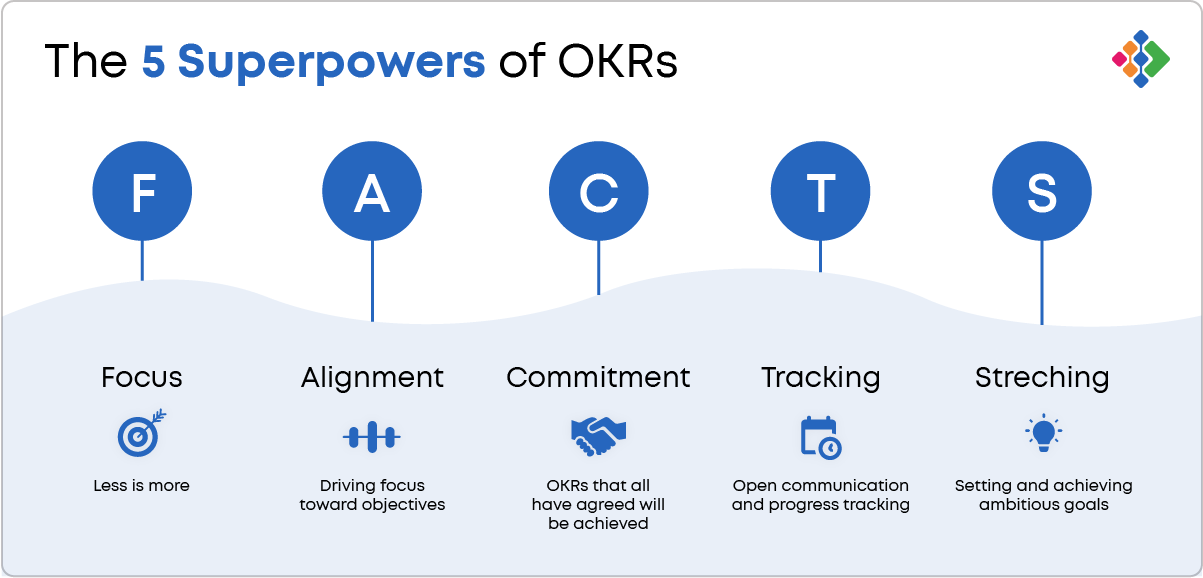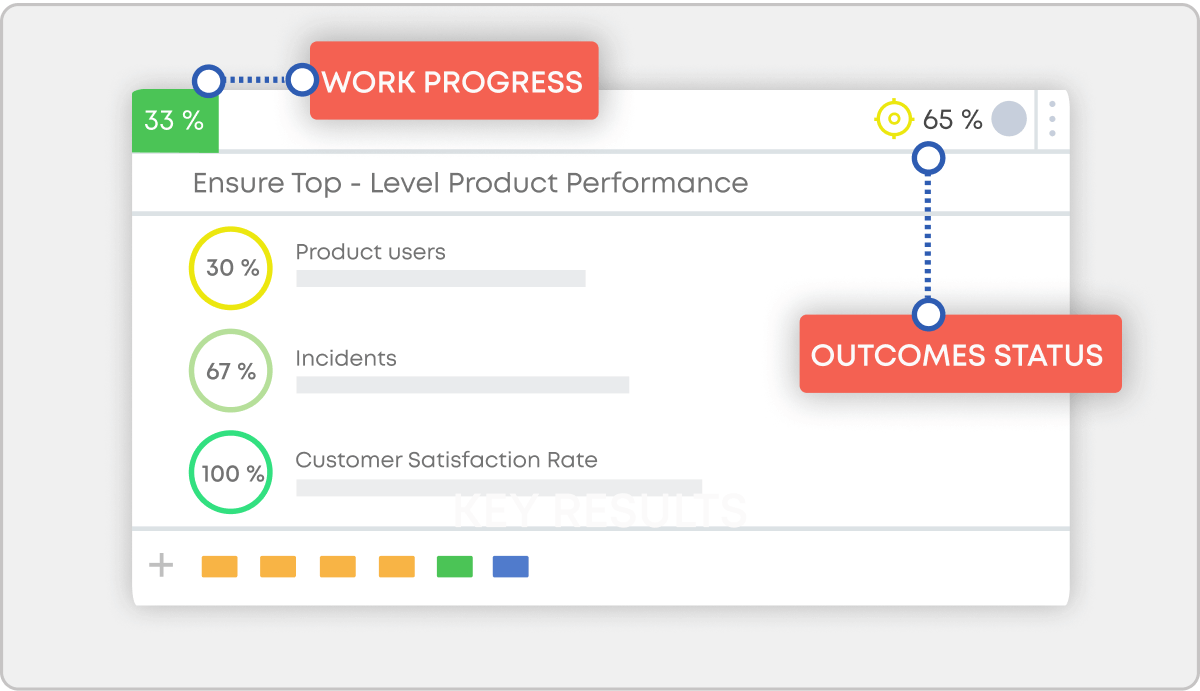Objectives and Key Results (OKRs) have been gaining popularity in the business world as a strategic goal-setting framework. Initially introduced in the 1980s by Intel's CEO Andy Grove, OKRs have been used by major companies like Google, Amazon, and Netflix to drive focus, alignment, and commitment toward achieving their goals.
As author John Doerr states in his book “Measure What Matters,” OKRs provide several intrinsic benefits, neatly summarized by the acronym "F.A.C.T.S." This acronym stands for focus, alignment, commitment, tracking, and stretching.
In this article, we will explore the five key benefits of OKRs and how they can transform your organization's goal-setting process. From increased focus and alignment to promoting commitment and stretching one's capabilities, OKRs have proven to be a powerful tool for achieving ambitious objectives.
Whether you are a startup, a small business, or a large corporation, understanding the intrinsic benefits of OKRs can help you harness their full potential and drive success. So, let's dive into the world of OKRs and learn how they can benefit your organization.
What Are OKRs?
OKRs (Objectives and Key Results) is a goal-setting framework that helps organizations and individuals define, measure, and track their objectives’s progress towards achieving them.
Think of Objectives as ambitious and qualitative goals that aim to significantly impact an organization's performance. Key Results, on the other hand, are quantitative measurements that indicate whether you've achieved or are moving forward toward those objectives.
OKRs provide a clear and transparent way to align everyone's efforts toward common goals and drive focus, accountability, and continuous improvement.
Why Use OKRs?
In the conventional management approach, companies establish big organizational objectives at the start of the year, only to see them fade into oblivion within a month. This results in a passive management style that challenges leaders when measuring and monitoring their organization’s advancement toward achieving these goals.
Executives and managers often need help to understand the performance levels of various teams. This can hinder the alignment of different teams with company-level goals, making it difficult to understand their impact on the organization's priorities.
To address this challenge, companies often establish goals using tools such as Microsoft PowerPoint, Excel, or Google Docs and email these objectives to their teams and departments. However, this method is inherently static, making tracking and managing goal progression challenging for many companies.
With such static approaches, goals remain hidden in real-time, and individuals struggle to connect their daily work to these objectives. To address this issue, numerous companies have embraced the OKRs (Objectives and Key Results) goal-setting framework.
Together with the OKRs framework, you can leverage OKR software like Businessmap to maintain alignment and visibility on company-level objectives so everyone prioritizes their efforts and focuses on what really matters.
What Are the 5 Main Benefits of OKRs, Plus 4 More?
In the realm of goal setting and performance management, Objectives and Key Results (OKRs) have emerged as a powerful tool to drive organizational success. This framework, popularized by the likes of Google and Intel, has gained widespread recognition for its ability to enhance productivity and focus within companies.
At the heart of OKRs lie a set of intrinsic benefits, beautifully encapsulated by John Doerr, the renowned author of "Measure What Matters," in the acronym "F.A.C.T.S." These five fundamental pillars—Focus, Alignment, Commitment, Tracking, and Stretching—constitute the bedrock of OKRs and are instrumental in realizing their true potential.
In the following sections, we will delve deeper into each of these intrinsic OKR benefits, exploring how they contribute to organizational success and why they are essential for any company seeking to unlock its full potential.

The 5 Superpowers of OKRs (Source: whatmatters.com)
1. Focus: Less Is More
Focus is the first key benefit of OKRs. By setting a limited number of objectives and key results (KRs), organizations can ensure that their efforts and resources are concentrated on what truly matters. Having fewer objectives fosters clarity and prevents teams from spreading themselves too thin, promoting more productive and efficient work.
For example, in Businessmap, we’ve made it a good practice to set WIP limits at the OKRs level. This way, we ensure that everyone stays focused, and we actually prove that less is more. A best practice is to have between 3 and 5 OKRs per quarter. Every team is different, but from our experience, we don't recommend having more than 3-4 OKRs in progress at a time.
2. Alignment: Driving Focus Toward Objectives
OKRs encourage alignment across an organization. When everyone's goals are transparent and connected to the overarching company objectives, teams can work cohesively towards a common purpose. This alignment ensures that all efforts are directed toward achieving strategic priorities and reduces the risk of working at cross-purposes.
For example, in Businessmap, every team aligns their team-level OKRs to the company-level OKRs. To preserve agility, we don't encourage blindly cascading top-down OKRs where company-level Key Results become objectives of different departments or teams. Instead, focus on decentralizing control and let teams set up their own OKRs based on the high-level goals.
3. Commitment: OKRs That All Have Agreed on Will be Achieved
OKRs promote commitment by involving team members in the goal-setting process. When individuals have a say in defining their team objectives and key results, they are more likely to take ownership of their work and feel a sense of accountability for achieving those goals. This commitment leads to higher engagement and motivation.
4. Tracking: Open Communication and Progress Tracking
OKRs facilitate open communication and progress tracking. By regularly updating and discussing OKR progress, teams and individuals can review the strategic direction, make necessary adjustments, and stay on course. This tracking mechanism promotes transparency and accountability, making it easier to identify and address issues as they arise.
To achieve strategic alignment, the goals must be linked to the progress of the work. For example, does working on item “X” lead us to real results? The idea is to visualize and track this connection in one place.
That's why at Businessmap, our practice is to visualize OKRs directly on each project in our portfolio. This way, we manage OKRs by keeping track of how the progress of the work (project) affects the goals (Outcomes). In other words, we link outputs and outcomes together to bring our strategic goals into reality.

Measure OKRs based on the progress of both goals and work activities
5. Stretching: Setting and Achieving Ambitious Goals
The "Stretching" aspect of OKRs encourages organizations to set ambitious goals that challenge their limits. Instead of settling for mediocrity, OKRs push teams to reach for significant achievements. This can lead to a culture of innovation, improved performance, and continuous improvement as individuals and teams strive to exceed their own expectations.
While the 5 intrinsic benefits of Objectives and Key Results (OKRs) - focus, alignment, commitment, tracking, and stretching - form the core of this goal-setting framework, the advantages of OKRs extend beyond these fundamental pillars. In addition to these foundational benefits, OKRs offer many other essential advantages that contribute to organizational excellence.
We will explore each of these additional benefits of OKRs in-depth, shedding light on how they complement the core advantages of the framework and contribute to creating Agile, engaged, and high-performing organizations. Together, these benefits form a comprehensive framework for driving success in a rapidly changing and competitive business landscape.
6. Agility and Adaptability
In an ever-evolving business landscape, agility and adaptability are paramount. OKRs foster an environment where teams can swiftly respond to changing circumstances and market dynamics.
By regularly setting and adjusting objectives, organizations can pivot when necessary, ensuring their efforts remain aligned with the most current strategic priorities.
7. Autonomy and Self-Organization
Empowering teams and individuals to take ownership of their goals is a hallmark of OKRs. This autonomy does not only boost employee morale but also leads to more innovative solutions.
When teams have the freedom to determine how best to achieve their objectives, they are more likely to come up with creative and effective strategies, driving the organization forward.
8. Bridging the Gap between Strategy and Execution
OKRs bridge the gap between strategy and execution by aligning organizational objectives with measurable key results. Clear and ambitious objectives connect directly to the overall strategy, while specific key results provide quantifiable milestones.
Using both top-down and bottom-up approaches ensures alignment at all levels, focusing efforts on strategic priorities. Regular check-ins enable continual refinement, fostering a culture of accountability and transparency. OKRs offer a structured, data-driven approach that translates strategic vision into actions, ensuring cohesive progress toward overarching goals.
9. Team Engagement
Engaged team members are a key driver of organizational success. Being involved in the goal-setting process and providing clarity on how their work contributes to larger objectives, OKRs significantly boost their engagement. When employees understand their role in the bigger picture and see the impact of their efforts, they are more motivated, committed, and satisfied in their work.
In conclusion, the power of Objectives and Key Results (OKRs) lies in their ability to harness the five major benefits of OKRs - focus, alignment, commitment, tracking, and stretching - to propel organizations toward greater success. They form the cornerstone of the OKR approach, creating a framework that empowers teams and individuals to achieve remarkable results.
Together, these five intrinsic benefits create a powerful synergy that not only enhances performance but also cultivates a dynamic and adaptable organizational culture. OKRs become more than just a goal-setting tool; they become a vehicle for driving excellence, unity, and growth within an organization.
As you embark on your OKRs journey or seek to refine your existing practices, remember that the "F.A.C.T.S." are not just abstract concepts but actionable principles that, when embraced, can lead to significant achievements.
By focusing on these pillars, you can harness the full potential of OKRs and pave the way for a future filled with success, innovation, and continuous improvement.
Related Articles:
Businessmap is the most flexible software, helping your company gain visibility across all projects/portfolios, align on goals, and deliver quality work faster.

Mila Chervenkova
Marketing Expert | Agile, Kanban & OKR Practitioner
Mila is a seasoned marketing professional with a rich background in product marketing, content creation, and website optimization. Years of Practicing Kanban, Agile, and OKR practices have made her an expert in creating powerful productivity habits.



